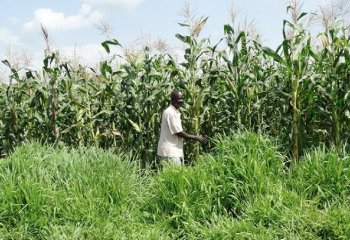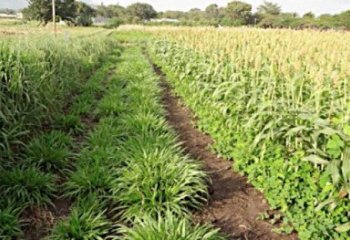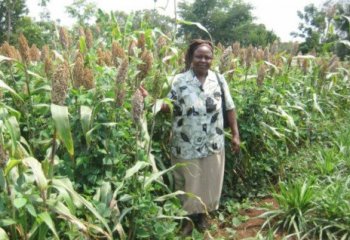A climate-smart version of the icipe push-pull technology is enabling farmers living in some of the East African regions most severely affected by climate change to stabilise their cereal–livestock mixed production systems.
In a paper published in the recent issue of Field Crops Research journal, icipe and collaborators show that the climate-smart push pull is not only enabling farmers living in such areas to continue cultivating cereals, but to also increase yields by 2.5 times, and in addition, integrate dairy farming into their production systems, despite challenges posed by climate of change.
© icipe
Push-pull is a platform technology developed over the past 20 years by icipe in collaboration with Rothamsted Research, United Kingdom, and partners in eastern Africa. This simple cropping strategy simultaneously addresses the five key constraints of cereal–livestock mixed production systems in Africa – insect pests (stemborers), the parasitic weed Striga (and other weeds), poor soil fertility, soil moisture management, while also fulfilling the need for high quality animal feed.
The push-pull technology involves intercropping cereals with a pest repellent plant, such as desmodium, which drives away or deters stemborers from the target food crop. An attractant trap plant, for instance Napier grass (Pennisetum purpueum), is planted around the border of this intercrop, with the purpose of attracting and trapping the pests. As a result, the food crop is left protected from the pests. In addition, desmodium stimulates suicidal germination of Striga and inhibits its growth. Push-pull also has significant benefits for dairy farming, since silverleaf desmodium (Desmodium uncinatum) and Napier grass are both high quality animal fodder plants. Additionally, desmodium is an efficient nitrogen fixing legume, which, therefore improves soil fertility. Moreover, because both plants are perennial, push–pull conserves soil moisture and continually improves soil health.
Currently, close to 110,000 farmers in Africa are using the push-pull technology. Of these farmers, 42,000 of them are applying a climate-smart version of push-pull, which has been developed over the past four years by icipe and partners in relation to the increasingly dry and hot conditions associated with climate change. The climate-smart push-pull involves the use of drought tolerant repellent and trap crops, Greenleaf desmodium (Desmodium intortum) and Brachiaria cv Mulato, as intercrop and border crops respectively. The farmers currently applying this adapted version of push-pull are living in the drier areas of western Kenya, eastern Uganda, Lake Victoria basin, Tanzania, and northern Ethiopia.
The recently published study is based on an evaluation conducted by icipe and collaborators to assess the impact and effectiveness of the climate-smart push-pull against stemborers and Striga,
© icipe
and its ability to increase cereal yields. The findings of the assessment, which was conducted in 400 selected farmers’ fields in Kenya, Uganda and Tanzania, show that the climate-smart push-pull effectively controls stemborers and Striga, and enhances maize production, at levels similar to the conventional push-pull technology.
“We found that in the fields of farmers using the climate-smart push-pull, only about 5% of the maize crop was destroyed by stemborers. In contrast, farmers not using the technology lost an approximate 40% of their maize crop to stemborer damage,” explains icipe scientist and lead study author, Dr Charles Midega.
“In addition, our study showed that the climate-smart push-pull effectively controlled Striga, as the noxious weed barely emerged in the fields where the technology was applied. This evidence was supported by the fact that, in neighbouring fields not using the climate-smart push-pull, an average of 20 Striga plants emerged around each individual maize plant,” he furthers notes.
Dr Midega adds that as a result of the effectiveness of the climate-smart push-pull in controlling Striga and stemborers, maize yield improved significantly, with farmers using the technology harvesting around 2.5 times more than those not applying it. Climate-smart push-pull farmers harvested an average of 4 tonnes of maize per hectare, while the other farmers obtained an average of 1.5 tonnes per hectare.
“These findings indicate that the climate-smart push-pull provides an important opportunity, as it makes cereal–livestock mixed production systems resilient under varying weather conditions. It also enables the production of cereals in previously unsuitable regions, while spreading the other benefits of the push-pull technology, such as dairy farming, to such regions. The climate-smart
© icipe
push-pull therefore effectively contributes towards improving food security and incomes at household and national levels. Our goal is to make the technology accessible to millions of smallholder farmers living in the drier regions of SSA,” explains Dr Midega.
“Overall, the icipe study reveals that innovative improvements on existing agricultural technologies to reinforce them against weather fluctuations can enable farmers in Africa to produce the same, or even more crop yields, as under previous optimal conditions. In addition, since farming systems in SSA are dominated by mixed crop-livestock systems, and cultivable land is becoming less and less due to population increase, there is need for technologies such as the climate-adapted push–pull, which will allow intensified agriculture,” notes Prof. Zeyaur Khan, icipe leader of the push-pull programme.
“The push-pull technology is women-friendly and alleviates a number of burdens faced by African women farmers, for instance, spending substantial amounts of time hand weeding and collecting animal feed, among other tasks. About 60% of the farmers who have adopted push-pull are women, who no longer have to undertake these gruelling tasks. Once the ‘push-pull’ plots are established, they require very little weeding. In addition, since push-pull prevents the germination of Striga, women no longer have to spend hours uprooting it. They also do not have to travel long distances to collect poor quality animal feed any longer, because the push-pull intercrops provide high quality fodder. I grew up in a remote village in Ethiopia, and I have done some of these backbreaking tasks. I am delighted that we at icipe are contributing to empowering women,” says Dr. Segenet Kelemu, Director General and Chief Executive Officer of icipe.”
Climate change and agriculture in sub-Saharan Africa
As a result of climate change, most of sub-Saharan Africa (SSA) is becoming hotter with less and unpredictable rainfall, leading to larger arid and semi-arid zones. Climate-induced impacts are also accelerating soil degradation, while increasing pest populations, enabling their spread to new geographical areas, and enhancing the vulnerability of crops to pest attacks. Climate change is also elevating Striga menace, as the weed’s impact is most severe in degraded environments that have low soil fertility and low rainfall. In general, smallholder farmers, who produce most of the food consumed in SSA lack appropriate ways to limit or reverse the adverse effects of climate change. Climate change is therefore expected to have significant impact on SSA’s fragile food security situation. The region has extremely low yield of staples, such as cereals, and the expected decline in agricultural productivity will worsen food insecurity.
Research Details
- Publication: Midega C.A.O, Bruce T.J.A., Pickett J.A., Pittchar J.O., Murage A. and Khan Z.R. (2015)Climate-adapted companion cropping increases agricultural productivity in East Africa
- Available at: http://www.sciencedirect.com/science/article/pii/S0378429015001884
- Funding: This study was primarily fundedby the European Union, with additional funding from Biovision Foundation, Switzerland, Bill and Melinda Gates Foundation and the UK’s Department for International Development (DFID). It was conducted in collaboration with Rothamsted Research, UK, which receives grant-aided support from the Biotechnology and Biological Sciences Research Council (BBSRC), UK, with additional funding provided under the Biological Interactions in the Root Environment (BIRE) initiative.
- Corresponding author: Charles Midega, icipe, cmidega@icipe.org
Media Contacts
- Liz Ng’ang’a, Communications Consultant, icipe, Lnganga@icipe.org, +254 (0) 715 805 051
- Photos: https://www.flickr.com/photos/icipeinsects/shares/1907Jq



